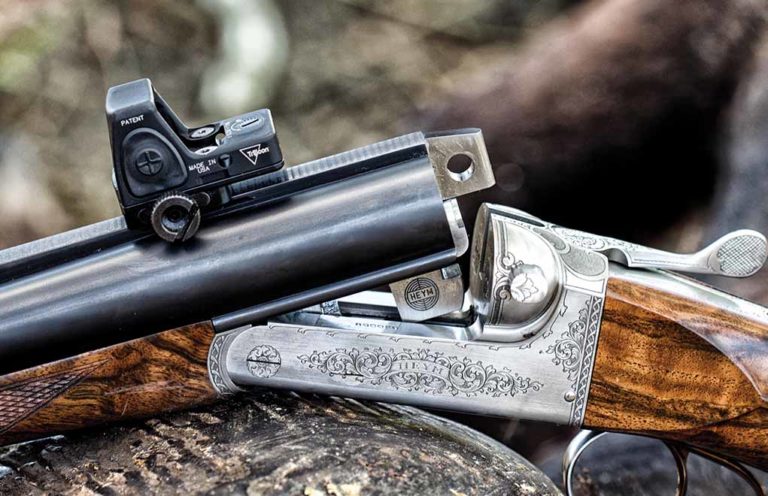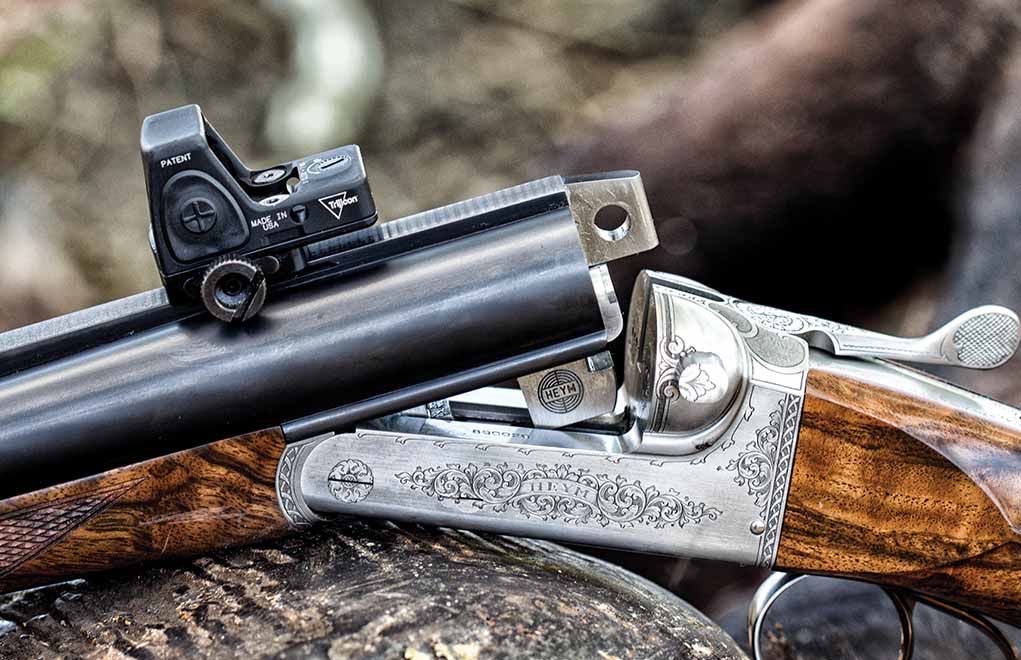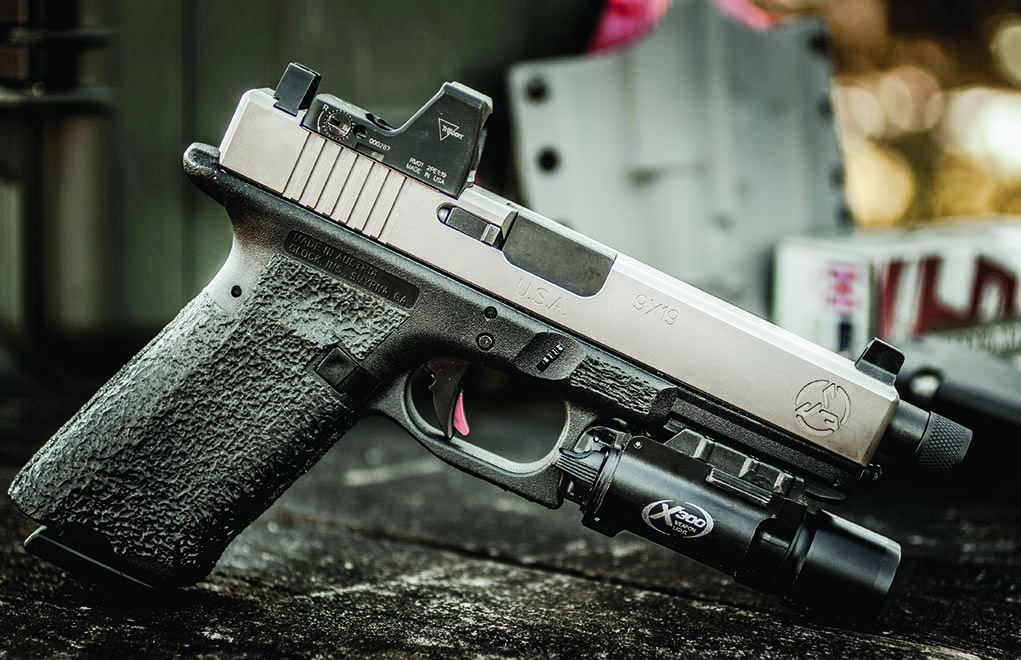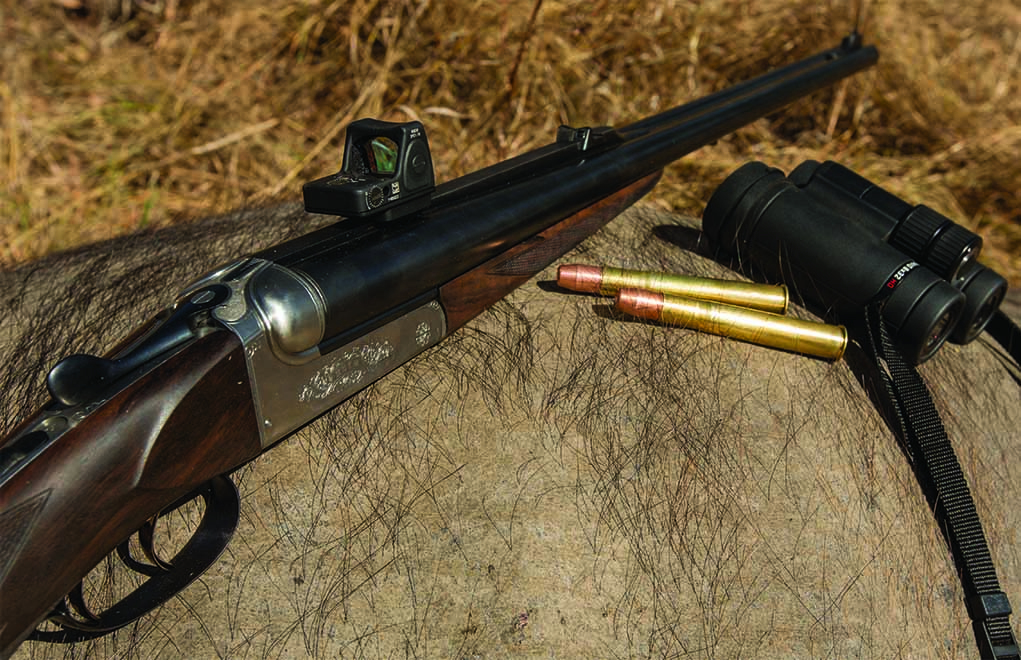
Somewhere between open sight and riflescope, the Trijicon RMR finds the perfect middle ground.
Since the invention of the firearm, man has tried his best to develop a system for aiming the gun easily and accurately. There are a number of solutions, though none of them are absolutely perfect.

The simplest designs evolved into the two-piece iron sights we’re all so familiar with. While that system certainly has a ton of applications, it’s handicapped by the user’s ability to focus both the target and the sights. As humans age, our eyes lose the ability to focus on tiny objects, especially up close. It will happen.
On a defensive handgun, the mantra of “front sight-focus” is a glaring example of the obstacles encountered when using iron sights. Because of the difficulty of quickly focusing on both the target and the front sight, shooters train to use a grip and stance that best allows the sights to be aligned under stress.
A rifle, under most circumstances, must be much more carefully aimed. Using a peep sight at the rear of a rifle will increase the sighting radius and also allow the eye to naturally center the front sight in the circle, removing one part of the iron-sight equation. Still, we’re married to the diameter of the front bead on a rifle, and sometimes that bead can be as much as 10 or more MOA. That’ll cover a pie plate at 100 yards and a garbage can lid at 200 yards, and while the famous 6 o’clock hold gives some relief, there’s still a bunch of your target covered up when the distances get longer.

A telescopic sight—our common riflescope—has certainly come a long way in recent years. The scope does some wonderful things, including magnifying the target and putting the reticle and target on the same focal plane. In certain instances, however, the tunnel vision of even the lowest power scopes can be a hindrance, especially on dangerous game at close quarters.
The debate has long raged among both dangerous game hunters and professional hunters between low-powered scopes and iron sights. While the scope solves the focus issue, it can affect the balance of a quick-pointing dangerous game rifle. I was looking for a solution somewhere in the middle … providing the balance and lightning-fast target acquisition of an iron-sighted rifle, yet with the single-focal plane of the scope—without the tunnel vision.
Here’s news for ya: Reflex sights aren’t just for pistols.

My particular favorite is the Trijicon RMR (Ruggedized Miniature Reflex) sight. I’ll also shamelessly get this out of the way upfront: When Trijicon includes the word “rugged” in the product name, they mean it.
Trijicon RMR Down Under
I found myself halfway around the globe, in a truly remote part of Australia’s Northern Territory, with Heym USA’s Chris Sells and professional hunter Graham Williams, with a fantastic Heym Model 89B double rifle in .470 Nitro Express over my shoulder. We were hunting Asiatic water buffalo, a species introduced to the Australian continent in the early 19th century and classified as invasive.
The .470, while equipped with good iron sights, wore a Trijicon RM09 with a 1-MOA red-dot and was sighted to be dead-on at 100 yards. Water buffalo are where they are, and while they’re not as switched-on as Cape buffalo—probably due to a lack of predators—they’re huge animals, with a big bull weighing in over a ton. The terrain in that part of Australia ranges from brushy thickets to open meadows and gully ridden lowlands, and buffalo were everywhere.

We’d spotted what would become my bull while skirting the edge of a small drainage; they were lying down about a quarter-mile up the slope, thinking about whatever buffalo think about. Graham and I made a plan to use what little cover we had to get within range of this handsome buffalo. Our plan worked—perhaps a little too well.
We ducked behind a slight hump in the topography, and working from tree to tree, we used the wind perfectly to get within 50 yards of the bull. Thinking we’d pull up and take the shot, I was a bit astounded when Graham motioned for me to follow, getting even closer. At a mere 17 paces, the bull became aware of us and gained his feet when Graham gave the order to shoot.
The double came to shoulder fluidly, and with both eyes open, I put the red dot just behind his shoulder as he whirled. The right barrel slowed him, and the left barrel saw him pause to gather strength; two more 500-grain North Fork solids sealed the deal. The rifle behaved much like a shotgun, with the Trijicon unit requiring very little thought—it worked naturally, the shots going exactly where the dot indicated.

Two days later, I’d hand the Heym double over to Chris, and he’d use that same rig to take an equally impressive bull at over 125 yards, giving a clinic on how to shoot a double rifle. His bull took the first shot just below the point of the shoulder, and he delivered a second about 4 inches away from the first while the bull was running. The grinning Chris was the first to admit he might not have made those shots in the same manner with the traditional iron sights on the rifle.
Little Details
The Trijicon RMR has been updated to what they call the Type 2, which has a beefier electronics system and weighs a mere 1.2 ounces, making it perfect for maintaining the balance of any firearm.
You’ll need a mounting solution for whatever gun you’re pairing it with. In the case of the Heym 89B, there’s an aluminum adapter that mounts to the rib and is held in place with a thumbwheel. Trijicon has models that mount to a Picatinny rail and other popular systems, and the footprint of the Type 2 is identical to the original. At just under 2 inches long and an inch high and wide, it doesn’t obscure the shooter’s view and is mounted low enough to the bore that cheek weld isn’t lost.

Three choices of dot sizes are available: 1 MOA, 3.25 MOA and 6 MOA. Quite obviously the larger the dot, the faster it can be acquired, and the 3.25 and 6 MOA dots make perfect sense for any close-quarters firearm. The 1 MOA model is a perfect choice for a hunting rifle. Covering just 1 inch at 100 yards, this sight is ideal for the rifleman who likes the visual freedom of iron sights yet prefers the single-focal plane view. Shots can be placed as precisely as the shooter can hold the rifle, and even when looking into the sunrise or sunset, the dot is bold and visible.
The dot of the RM09 I used and tested was adjustable for intensity with soft-touch buttons. Hold both buttons down to power off the unit. The adjustments are 1 MOA, with graduations on the dial, and clicks for each increment. When I was doing the load development for my Heym .470 double, the Trijicon was quickly zeroed and the adjustments I needed were as accurate as I could ask for. Having the RMR on board for the load development work saved ammunition and my shoulder—I knew the shots were placed properly.
The RMR’s lens is fully coated for minimal color shift in the window, and I experienced no issues when using the unit in bright sun, nor when holding on a black buffalo’s shoulder in the dappled sunlight. Trijicon indicates that the unit is waterproof to 20m depth. A single CR2032 lithium battery runs the unit; if you leave it untouched for 16½ hours, the illumination level automatically goes back to ambient lighting conditions. I wish I could tell you how long the battery lasts, but I haven’t yet reached the end of this battery’s life. The battery contacts have been designed to work in the most inclement conditions, and I’ve never experienced any loss of power, with either the original model or the Type 2.

Trijicon offers a limited lifetime warranty, stating that the electronics are warrantied for 5 years from date of manufacture. Having used this sight in Australia, Mozambique and here in the States—on rifles with serious recoil—I can say that the RMR is rock solid. While the slamming action of a 1911 can be tortuous on any piece of electronics, I’d wager it pales in comparison to a pair of rapid shots from a .470 Nitro Express, with each shot generating over 5,000 ft-lb of energy.
In addition to black, the RMR is available in a dark flat earth Cerakote finish and a sniper gray Cerakote finish. Depending on options, the list price runs between $699 and $749, with street prices running between $550 and $650, not counting the necessary mounting adapter.
While there are those who might feel that even the tiny Trijicon sight will befoul the classic lines of a fine double rifle or sleek lever gun, the increase in accuracy ought to sway that opinion. Plus, the RMR is quickly removed from nearly any mounting situation, easily restoring the gun’s silhouette. Should you have the opportunity to try a rifle with an RMR on top of it, I’d wager you’ll become a fan.
For more information on the Trijicon RMR, please visit trijicon.com.
Editor's Note: This article originally appeared in the November 2020 issue of Gun Digest the Magazine.

Next Step: Get your FREE Printable Target Pack
Enhance your shooting precision with our 62 MOA Targets, perfect for rifles and handguns. Crafted in collaboration with Storm Tactical for accuracy and versatility.
Subscribe to the Gun Digest email newsletter and get your downloadable target pack sent straight to your inbox. Stay updated with the latest firearms info in the industry.

![Best Concealed Carry Guns In 2025 [Field Tested] Wilson Combat EDC X9S 1](https://gundigest.com/wp-content/uploads/Wilson-Combat-EDC-X9S-1-324x160.jpg)


![Best 9mm Carbine: Affordable PCCs [Tested] Ruger Carbine Shooting](https://gundigest.com/wp-content/uploads/Ruger-Carbine-Shooting-100x70.jpg)
![Best AR-15: Top Options Available Today [Field Tested] Harrington and Richardson PSA XM177E2 feature](https://gundigest.com/wp-content/uploads/Harrington-and-Richardson-PSA-XM177E2-feature-100x70.jpg)
